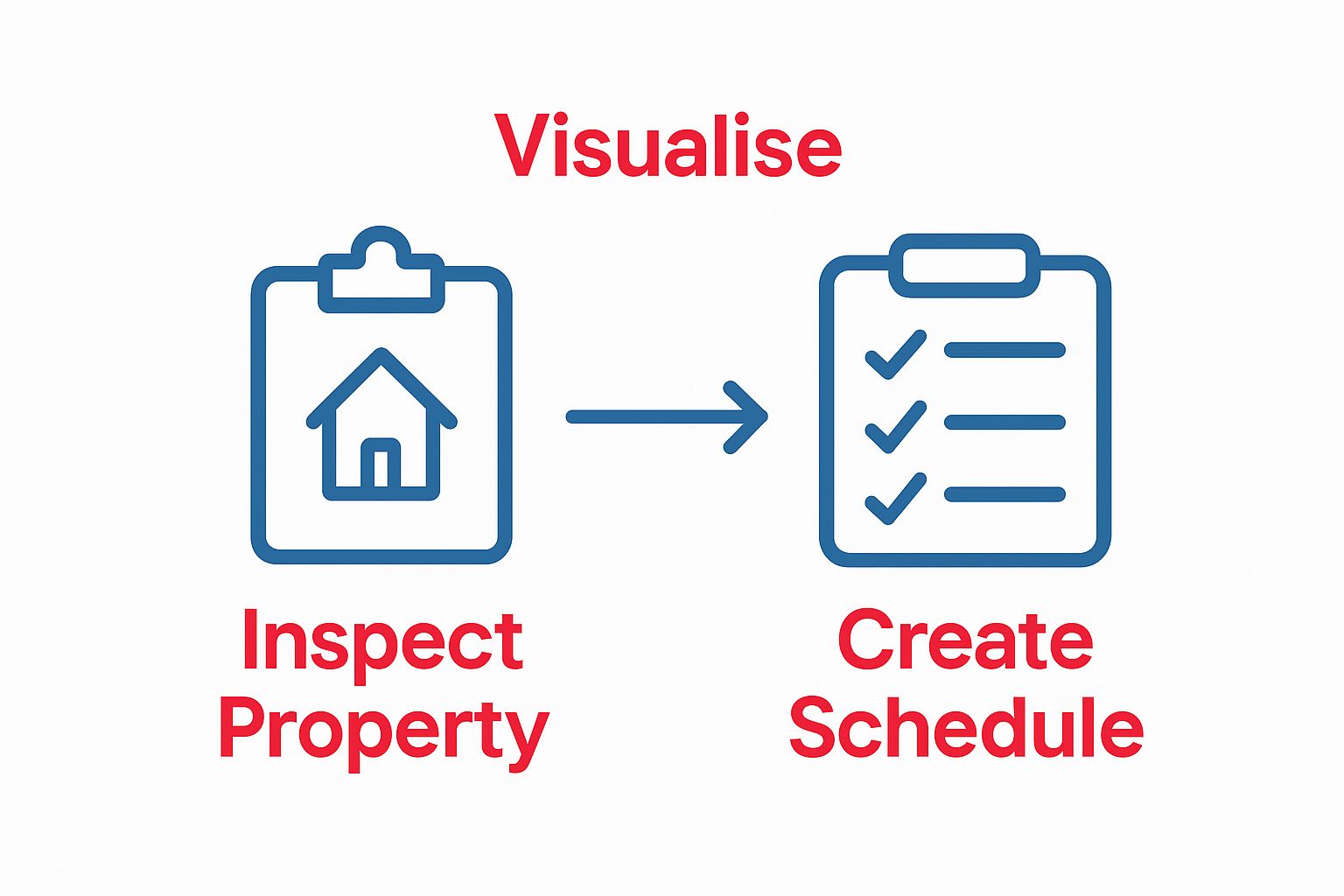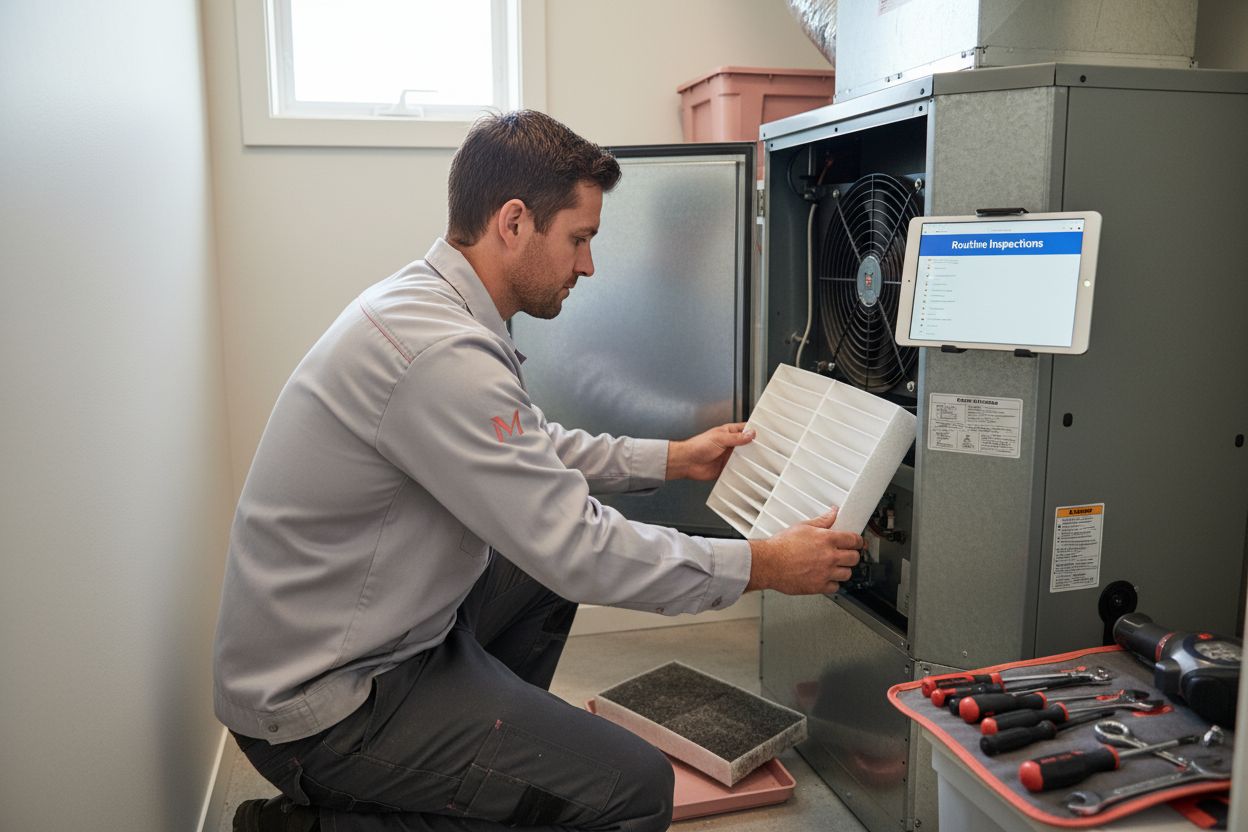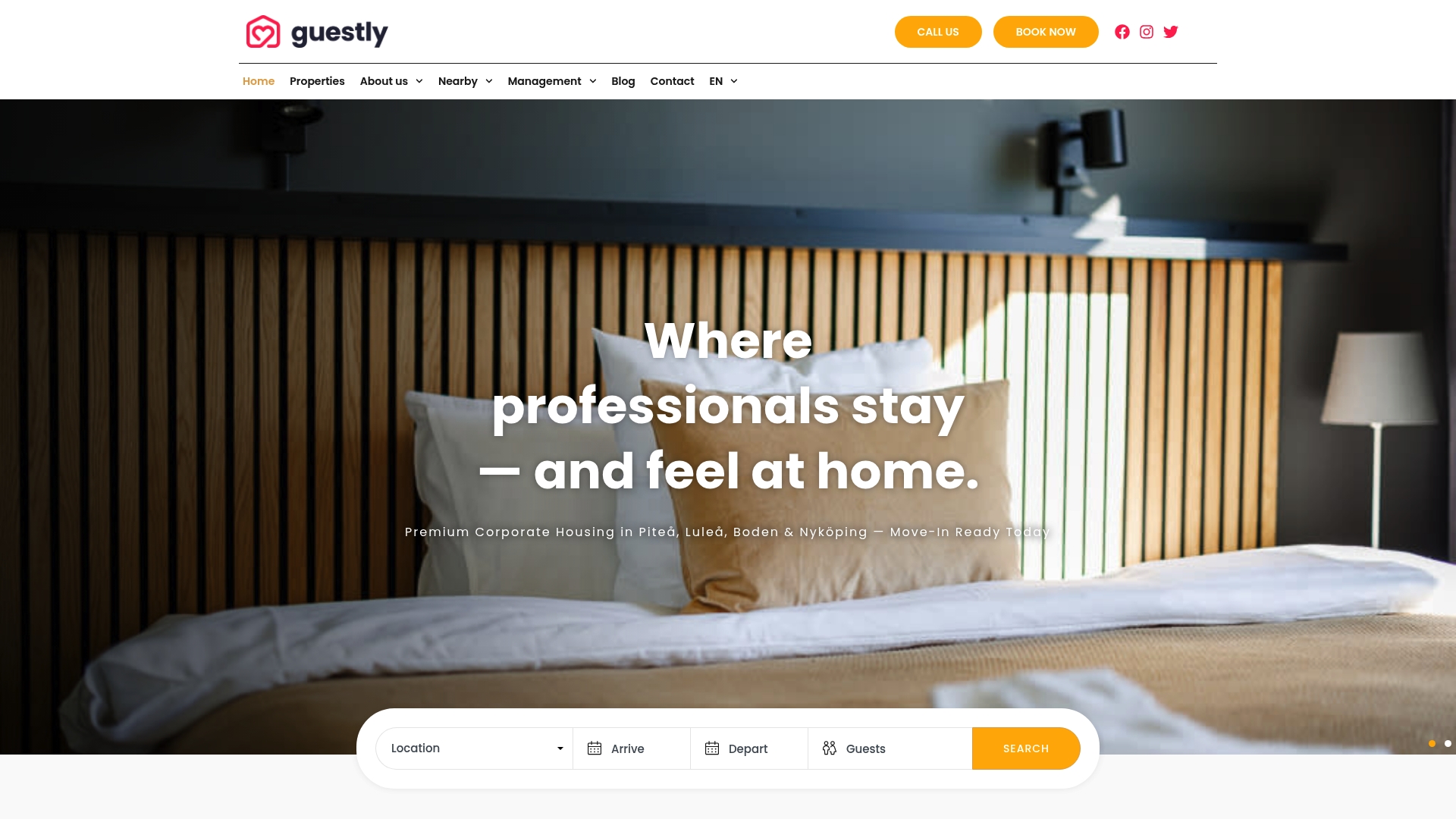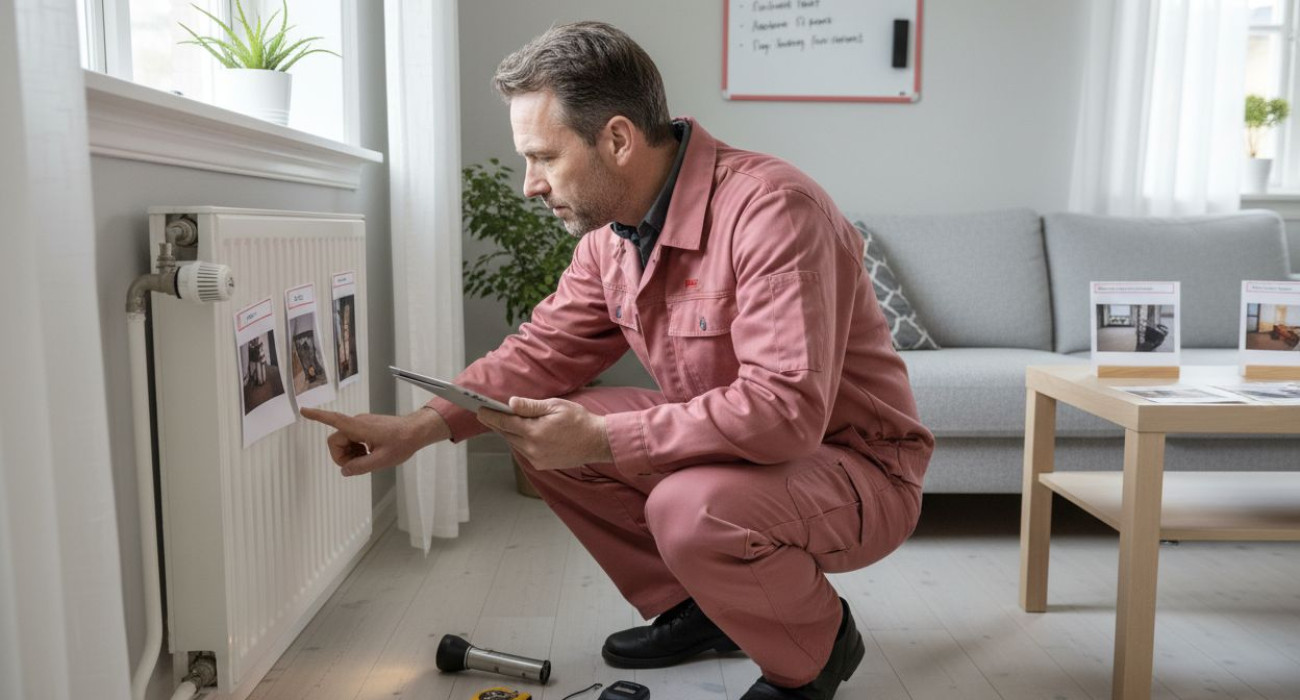Looking after a rental property can feel like a never-ending challenge. Every loose tap or missed gutter clean hints at trouble, yet landlords who invest in regular maintenance spend up to 40 percent less on repairs in the long run. Most people expect maintenance to be a hassle or just extra paperwork, but the surprising truth is that a solid system frees your time and puts more money in your pocket.
Table of Contents
- Step 1: Assess Your Property’s Current Condition
- Step 2: Create a Maintenance Schedule and Checklist
- Step 3: Conduct Routine Inspections and Repairs
- Step 4: Implement Preventative Maintenance Practices
- Step 5: Verify All Maintenance is Completed Timely
Quick Summary
| Key Point | Explanation |
|---|---|
| 1. Assess property condition thoroughly | Conduct comprehensive inspections to identify potential issues early. Proper assessments help avoid costly repairs and maintain value. |
| 2. Develop a structured maintenance schedule | Organise maintenance tasks by timeframe to ensure consistency. Digital tools can help manage reminders and track task completion. |
| 3. Conduct regular inspections proactively | Schedule property inspections every few months to identify and address maintenance needs promptly, ensuring tenant satisfaction. |
| 4. Implement preventative maintenance strategies | Establish protocols for seasonal maintenance to prevent environmental damage. Smart home technology can help monitor property conditions in real-time. |
| 5. Verify all maintenance is completed timely | Establish a system for tracking and verifying maintenance work. Follow-up inspections and documentation enhance accountability and quality control. |
Step 1: Assess Your Property’s Current Condition
Assessing your rental property’s current condition forms the critical foundation of effective maintenance. This initial step determines the comprehensive health of your investment, revealing potential issues before they escalate into costly repairs. A thorough property assessment allows property owners to create strategic maintenance plans that protect asset value and ensure tenant satisfaction.

Begin by scheduling a comprehensive visual inspection that covers both interior and exterior spaces. Walk through each room methodically, examining walls, floors, ceilings, electrical systems, plumbing, and structural elements. Look for subtle signs of wear, potential structural weaknesses, or emerging maintenance needs. Pay particular attention to high-traffic areas and spaces prone to moisture exposure, such as bathrooms, kitchens, and external walls.
Documentation becomes your strategic ally during this assessment. Develop a systematic approach to recording observations by creating a detailed property condition report. Utilize digital tools like smartphone apps or spreadsheet software to capture comprehensive information. Photograph each area systematically, ensuring clear images that highlight potential maintenance requirements. Include precise location details, measurement specifics, and timestamp information to create a robust baseline record.
For property owners seeking professional insights, consider engaging a qualified building inspector or property maintenance specialist. Professional Property Inspection Services can provide an objective, expert evaluation that goes beyond surface-level observations. These professionals can identify potential structural issues, recommend preventative maintenance strategies, and provide estimated repair costs.
Key verification criteria for a successful property assessment include:
- Comprehensive photographic documentation of all property areas
- Detailed written report capturing condition observations
- Identification of immediate and potential future maintenance requirements
- Estimated repair or replacement costs for identified issues
Remember that a meticulous initial assessment sets the stage for proactive property management. By investing time and careful attention in this first step, you create a strategic roadmap for maintaining your rental property’s long-term value and performance.
Step 2: Create a Maintenance Schedule and Checklist
Developing a comprehensive maintenance schedule and checklist transforms reactive property management into a proactive, strategic approach. This critical step builds directly upon your initial property assessment, translating observed conditions into a structured plan that preserves your rental property’s value and prevents costly unexpected repairs.
Begin by categorising maintenance tasks into distinct timeframes: daily, weekly, monthly, quarterly, and annual activities. Digital calendar tools and property management software can streamline this process, allowing you to set automated reminders and track completion of various maintenance tasks.
Consider using cloud-based platforms that enable easy sharing with maintenance professionals or property managers, ensuring everyone remains aligned on scheduled activities.
Your maintenance checklist should encompass multiple property systems and components. Focus on critical areas such as electrical systems, plumbing, heating and cooling infrastructure, structural elements, and exterior surfaces. For each task, document specific inspection criteria, potential warning signs, and recommended actions. Property Maintenance Research from National Landlords Association suggests creating granular checklists that cover everything from checking smoke detector batteries to evaluating roof conditions.
Implement a flexible yet disciplined approach to scheduling. While consistency is crucial, recognize that some maintenance tasks require professional expertise or seasonal considerations. Develop relationships with reliable contractors who can perform specialized maintenance and provide expert assessments. Integrate their recommended service intervals into your overall maintenance schedule, ensuring comprehensive coverage of your property’s needs.
Key verification criteria for an effective maintenance schedule include:
- Comprehensive documentation of all maintenance tasks with specific timeframes
- Clear assignment of responsibilities for each maintenance activity
- Digital or physical tracking mechanism for task completion
- Allocated budget for anticipated maintenance expenses
- Documented contact information for relevant maintenance professionals
Remember that a well-constructed maintenance schedule is a living document. Regularly review and update your checklist based on property condition changes, technological advancements, and lessons learned from previous maintenance experiences. By treating your maintenance schedule as an evolving strategy, you create a robust framework for protecting your rental property investment.
Step 3: Conduct Routine Inspections and Repairs
Routine inspections and repairs form the backbone of proactive property maintenance, transforming potential problems into manageable interventions. This critical step goes beyond simply identifying issues by implementing timely, strategic repairs that protect your rental property’s structural integrity and tenant experience.
Develop a systematic approach to property inspections that balances thoroughness with efficiency. Schedule regular walkthroughs that align with your previously created maintenance schedule, typically every three to four months. During these inspections, move methodically through the property, examining each room and system with a discerning eye. Pay special attention to areas prone to wear and potential damage, such as plumbing fixtures, electrical connections, flooring, and wall surfaces. Building Maintenance Guidelines from Royal Institution of Chartered Surveyors recommend a comprehensive approach that goes beyond visual assessment.
Equip yourself with the right tools and documentation methods to make these inspections effective. Bring a digital camera or smartphone for photographic documentation, a moisture meter to detect potential water damage, and a comprehensive checklist derived from your earlier maintenance planning. Capture detailed images of any identified issues, including precise location markers and condition descriptions. This documentation serves multiple purposes: tracking property condition over time, supporting potential insurance claims, and providing clear communication with maintenance professionals.
When addressing repairs, prioritize tasks based on urgency and potential impact. Minor issues like loose door handles or small paint chips can be addressed immediately during the inspection. More complex problems requiring specialized expertise should be scheduled with qualified professionals promptly. Develop relationships with reliable contractors who can respond quickly and provide high-quality workmanship. Consider creating a preferred vendor list with contact information, specialties, and past performance records.
Key verification criteria for successful routine inspections include:
- Comprehensive photographic documentation of property condition
- Detailed written report capturing all identified maintenance needs
- Immediate resolution of minor repair issues
- Scheduled professional interventions for complex maintenance requirements
- Updated maintenance log reflecting completed and pending repairs
Remember that routine inspections are more than a maintenance task they represent an investment in your property’s long-term value and tenant satisfaction. By approaching these inspections with diligence, thoroughness, and a proactive mindset, you transform potential problems into opportunities for preserving and enhancing your rental property’s performance.

Step 4: Implement Preventative Maintenance Practices
Preventative maintenance represents a strategic approach to property management that focuses on anticipating and mitigating potential issues before they escalate into costly repairs. This proactive methodology transforms maintenance from a reactive chore into a sophisticated risk management strategy that protects your rental property’s long-term value and operational efficiency.
Develop a comprehensive preventative maintenance strategy that addresses multiple property systems holistically. Begin by creating seasonal maintenance protocols that account for environmental challenges specific to your property’s location. For instance, prepare heating systems before winter and inspect cooling infrastructure prior to summer months. Building Maintenance Research from National Property Management Association suggests implementing systematic approaches that integrate technological monitoring with professional expertise.
Invest in smart home technologies and monitoring systems that provide real-time insights into your property’s condition. Modern sensors can track moisture levels, temperature variations, electrical load, and potential structural stress points. These technologies enable early detection of potential issues, allowing you to intervene before minor problems transform into significant structural challenges. Consider installing water leak detectors, smart thermostats, and vibration monitoring systems that can send immediate alerts to your smartphone or property management platform.
Establish relationships with specialized maintenance professionals who understand preventative maintenance principles. These experts can provide comprehensive system assessments, recommend targeted interventions, and help you develop nuanced maintenance strategies tailored to your specific property. Regular professional consultations can reveal potential vulnerabilities that might escape casual observation, providing an additional layer of proactive protection for your investment.
Key verification criteria for effective preventative maintenance include:
- Documented seasonal maintenance protocols
- Comprehensive technology-enabled monitoring systems
- Regular professional system assessments
- Updated maintenance logs reflecting preventative interventions
- Budget allocation for proactive maintenance activities
Remember that preventative maintenance is an ongoing process of learning and adaptation. Continuously refine your approach based on accumulated data, technological advancements, and insights gained from professional consultations. By treating preventative maintenance as a dynamic, evolving strategy, you create a robust framework that maximizes your rental property’s performance, durability, and long-term value.
Step 5: Verify All Maintenance is Completed Timely
Verifying timely maintenance completion is the critical final step in ensuring your rental property remains in optimal condition. This process transforms documented maintenance plans into actual performance, providing a systematic approach to quality control and accountability. Effective verification goes beyond simple record-keeping, becoming a strategic mechanism for maintaining property value and tenant satisfaction.
Implement a robust documentation and tracking system that allows for real-time monitoring of maintenance activities. Digital property management platforms offer comprehensive solutions that enable you to track work orders, schedule inspections, and maintain detailed maintenance logs. Property Management Verification Strategies from Royal Institution of Chartered Surveyors recommend creating multi-layered verification processes that combine digital tracking with physical inspections.
Develop a systematic approach to maintenance verification that includes multiple validation touchpoints. After each maintenance task, request detailed documentation from service providers, including before and after photographs, comprehensive work reports, and itemized expense breakdowns. Cross-reference these reports against your original maintenance schedule to confirm that all planned activities have been completed accurately and within the specified timeframes. Utilize digital tools that allow for electronic signatures, time-stamped documentation, and automatic compliance tracking.
Establish a follow-up protocol that ensures the quality and effectiveness of completed maintenance work. Schedule secondary inspections approximately two weeks after major maintenance activities to verify that repairs have been implemented correctly and no secondary issues have emerged. Create a standardized evaluation process that rates maintenance providers based on timeliness, quality of work, and overall professionalism. This approach not only verifies maintenance completion but also helps you build a network of reliable service professionals.
Key verification criteria for maintenance completion include:
- Comprehensive digital documentation of all maintenance activities
- Photographic evidence of completed maintenance tasks
- Detailed work reports from service providers
- Follow-up inspections confirming quality of maintenance work
- Performance ratings for maintenance service providers
Remember that verification is an ongoing process that requires consistent attention and adaptation. By treating maintenance verification as a dynamic, strategic activity, you transform potential administrative burden into an opportunity for continuous improvement. Your diligence ensures that your rental property remains a high-performing, well-maintained asset that delivers consistent value to both you and your tenants.
To help landlords organise the post-inspection process, the following table summarises key criteria for verifying that all maintenance tasks are properly completed and documented.
| Verification Step | Description | Purpose |
|---|---|---|
| Digital Documentation | Maintain detailed digital records of maintenance activities, including dates and descriptions | Ensures accurate, readily accessible maintenance history |
| Photographic Evidence | Obtain before and after images of completed maintenance tasks | Provides visual proof and supports quality assurance |
| Work Reports | Require comprehensive, itemised reports from service providers | Confirms scope of work and creates clear accountability |
| Follow-up Inspections | Conduct secondary inspections after major tasks | Verifies work quality and detects any outstanding issues |
| Provider Performance Rating | Evaluate service providers on timeliness and quality | Supports selecting reliable professionals in the future |
Ready for Truly Hassle-Free Property Maintenance?
You have read how comprehensive property assessments, detailed maintenance schedules, and proactive verification are crucial for rental property performance. Still, many owners struggle to keep up with inspections and urgent repairs, risking the property’s value and tenant trust. Outsourcing these essentials is not just convenient. For many, it is the smartest way to unlock stable returns and genuine peace of mind.

Let Guestly Homes shoulder the operational load so you do not have to chase service reports or worry about missed inspections. Our fully managed property solutions bring you frictionless, high-standard care, with every check, fix, and follow-up handled by professionals who always deliver. Visit Guestly Homes today and discover which management model matches your ambitions for hands-off profit and long-term asset protection. The next step to confident, proactive ownership starts now.
Frequently Asked Questions
How can I assess my rental property’s current condition effectively?
Begin with a thorough visual inspection of both interior and exterior spaces, focusing on high-traffic areas and moisture-prone locations. Document your findings with a detailed report and photographs to create a baseline for future maintenance needs.
What should I include in my rental property maintenance schedule?
Your maintenance schedule should categorise tasks into various timeframes, such as daily, weekly, and annual activities. Include checks for essential systems like plumbing and electricals, and set up reminders for each task to ensure nothing is overlooked.
How often should I conduct routine inspections of my rental property?
Aim to conduct routine inspections every three to four months to ensure timely identification of maintenance needs. During these inspections, focus on critical areas to address any minor issues before they escalate into costly repairs.
What are some key preventative maintenance practices I should implement?
Implement seasonal maintenance protocols based on your property’s location, such as preparing heating systems before winter. Introduce smart home technologies that monitor conditions and alert you to potential issues, allowing for early intervention before they develop into large problems.
How can I verify that all maintenance tasks are completed on time?
Establish a tracking system to monitor maintenance activities and request detailed reports from service providers. Schedule follow-up inspections to confirm repairs were executed correctly, ensuring the quality and effectiveness of all completed work.



